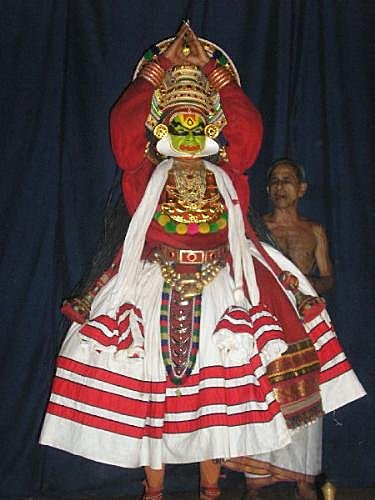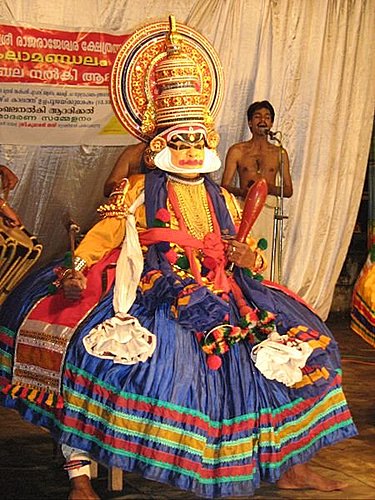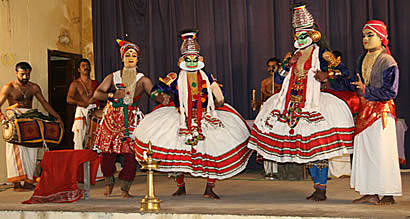



5/3/2008 in National Palace Museum, KathaKali was performed starting
from 6:30 pm. In accordance with the host’s indtroduction and
Mr. 吳德朗’s statements: Kathakali means a story play or a dance
drama. It originated from Ramanattom and Krishnanattom, and was
belonging to the South-Western coastal state of Kerala. Kathakali is primarily
a dance drama form and is extremely colourful with billowing costumes, flowing
scarves, ornaments and crowns. The dancers use a specific type of symbolic
makeup to portray various roles which are character-types rather than individual
characters. Various qualities, human, godlike, demonic, etc., are all represented
through fantastic make-up and costumes.
Since I did not take pictures on the scene, so try to get some photos (see the
attachments) from web for reference. This performance is bring me to remember
the Japanese traditional drama, Noh, played in National Palace Museum on
2/3/2007. To compare Indian KathaKali with Japanese Noh, there are some
findings as following:
1. Face:
The performers of KathaKali will make up and use different colors to portray
the characters, such as:
“green” is used to portray noble male characters;
“green background with red beard” is used to portray evil;
“lustrous and yellowish” is used to portray women and ascetics;
“black” is used to portray uncivilized hunters.
This kind of concept is similar to Chinese Beijing opera. As for Noh, the main
actor will wear the mask, and the side player will not do so. The Noh masks
normally portray female or nonhuman characters. Several types of masks, in
particular for female roles, are designed for slight adjustments in the position of
the head can express a number of emotions such as fear or sadness due to the
variance in lighting and the angle shown towards the audience. However, it is
not always possible to convey emotion for those masks of deities and monsters.
Usually, these performers are not frequently called to change emotional expression
during the course of the scene, or show emotion through larger body language.
Pursuant to the history, the roots of Noh can be traced back to the Tang
Dynasty’s theatricals, I wonder why it cannot be found the reflection of Chinese
opera on the point of “Face”.
2. Music
The actors of KathaKali never speak, its songs are set for “ragas” based on
Carmatic music. The instruments include a cylindrical drum, a drum held
horizontally, cymbals and a gong. In addition to those instruments, there
are two vocalists render the songs to compose Kathakali music. Noh is
chanted drama, the singing in Noh involves a limited tonal range, with lengthy,
repetitive passages in a narrow dynamic range. Apparently, melody is not the
focus of Noh singing. Still, texts are poetic, relying heavily on the Japanese
seven-five rhythm common to nearly all forms of Japanses poetry. From the
rhythm point of view, Kthakali’s music is more vivid than Noh’s.
3. Acting
Since KathaKali’s actors never speak, hence, the body performance will be
very important to it. Some particular facial expressions were developed to help
for telling the story, which are love, ridicule, fear, pity, anger, courage, disgust,
amazement, and peace. Within the performance of this time, actor’s eye
movements is impressive of me very much, his eyeballs can move very very fast
from any angle. Furthermore, characters used hand-gesture to enhance the
facial xprssions and unfold the tex of the drama. Mention to Noh, since its main
actor have to wear the mask, withhout facial expression, we have to rely on
player’s body language to know the emotion and will what they conveyed.
As our awareness, for Japanese culture, people care about the compliance of
social regulations more than the will of individual. Regarding this point, Noh
seems to interpret the personality of Janpanese society appropriately.
That night, with ending the KathaKali performance, husband, kids and I went
for the night market in a delight mood to eat some snacks. Like to watch
performances since they always bring some different feels to enrich the flat life.
In addition, through approaching the traditional performance of other countries,
we can know their culture and people more or less, ……..more understanding,
less fighting……..

沒有留言:
張貼留言